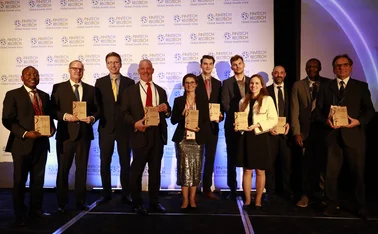
The winners of the 2017 Central Banking Awards
BoE, Valdovinos, Kohn and 15 other award recipients named

The Bank of England (BoE), Carlos Fernández Valdovinos and Donald Kohn were named central bank, governor and lifetime achievement award-winners respectively in the latest Central Banking Awards.
The BoE drew praise for its early handling of Brexit, acting as a source of stability for the UK while standing firm in the face of political pressure.
The judging panel, comprising members of Central Banking’s advisory board and editorial team, also noted the BoE had made significant efforts to boost transparency, forecasting and market operations, while also improving financial stability and cyber attack surveillance. Former US Federal Reserve officials Kevin Warsh and David Stockton, who led reviews of the BoE’s transparency and forecasting, praised the bank’s readiness to make improvements.
“The past year has presented many challenges, which our colleagues have met with their customary skill and dedication,” BoE governor Mark Carney tells Central Banking. “I am particularly proud of the progress we have made in embedding a culture of openness and challenge within the bank.”
Victorious Valdovinos
Valdovinos, governor of the Central Bank of Paraguay, has guided the small Latin American economy through a turbulent period marked by low commodity prices, regional political volatility and international market uncertainty. He has been heavily involved in fostering regional co-operation, speaking out about the benefits of macro-prudential tools and successfully lowered the central bank’s inflation target.
“Valdovinos has established strong links with our country in his academic and professional life,” says former Central Bank of Brazil governor Alexandre Tombini, now an executive director at the International Monetary Fund. “He has played a key role in fostering the dialogue among South American central bankers on critical issues in such challenging times.”
Valdovinos has played a key role in fostering the dialogue among South American central bankers on critical issues in such challenging times
Alexandre Tombini, IMF executive director
For three years in a row, the central bank, under Valdovinos’s leadership, has managed to keep the inflation rate below the bank’s 4.5% target, but within its tolerance band of two percentage points.
“Paraguay is not the typical recipient of such awards, but has started to draw the attention of the international community for its efforts and achievements related to sustainable growth,” says Valdovinos.
Kohn’s calming influence
Donald Kohn’s career, spanning four decades at the Federal Reserve and five years at the BoE, encapsulates the astonishing journey that developed-world central banks have undertaken during the past half-century. He was involved in the fight against inflation as well as the introduction of greater transparency at de facto independent central banks.
He was frequently described as a calm and reassuring presence by his peers at the height of the global financial crisis, when he worked tirelessly to ensure decisive action, while also looking out for possible unintended consequences.
“His objectivity, intelligence, tireless energy and iron will to get the job done epitomise the role of a dedicated public servant, and he stands as an inspiration to other central bankers around the world,” says Central Banking Awards Committee chairman Christopher Jeffery.

Kohn says he is “grateful” and “greatly honoured” to be “recognised by Central Banking”: “It’s been a fascinating and rewarding journey through the last 45 years of central banking, and an enormous privilege to take that journey alongside so many thoughtful and dedicated public servants like Paul Volcker, Alan Greenspan, Ben Bernanke, Eddie George, Mervyn King and Mark Carney, to name just a few.”
He adds that during his near half-century of public service, central banks earned “well-deserved reputations” for their “non-partisan expertise”, and have long been “among the most respected institutions in public life”. But these reputations were “dented” when they “didn’t see the global financial crisis coming or the full difficulties of recovery”, he tells Central Banking.
Nonetheless, many central banks were still entrusted with “maintaining financial stability alongside price stability” in the post-crisis world. The big challenge for central banks in the future, Kohn says, is to “improve performance and public regard” by “learning from the past”, “developing and acting on the expertise required to carry out new responsibilities”, and “improving our ability to explain our actions to the public and be held accountable for them in democratic institutions”.
Achieving these aims will not be easy, especially as populist leaders continue to blame unelected public officials and bureaucrats for continued sluggish economic growth.
Kohn calls on central banks to meet the challenges they face “in an increasingly rancorous political environment”, adding that this “only enhances both the need for institutions, like central banks, of unquestioned non-partisan expertise, but also makes achieving and maintaining that status even more difficult”.
‘Unconventional’ Krippner
Leo Krippner’s work on term structure modelling, meanwhile, has helped central bank policymakers to track and understand the effects of unconventional policies, and earned him the Economics in central banking award.
His ideas aim to quantify the effects of monetary policy below the zero lower bound – and in so doing, recognise that policy in the ‘new normal’ is driven not only by short rates, but also by the shape of the entire yield curve, and expectations on how it will evolve.
“Krippner’s measures are now in the toolbox of most central banks since the global financial crisis, and serve to directly inform policymakers,” says Sandra Eickmeier, of the Deutsche Bundesbank.
His work raises interesting possibilities for future research. One idea he would like to examine further is how term structure models interact with the macroeconomy – how growth and inflation affect the term structure, and vice versa.
Central bank successes
Winning Reserve manager of the year, the Bank of Israel showed how it carefully handled the evolution of its reserve management framework in the wake of the global financial crisis, expanding its investment universe and also making breakthroughs in its sensitivity analysis of near-optimal portfolios.

“The challenges for reserves management have dramatically increased because of the combination of the increase in the size of reserves in many countries and the very low – and even negative – yields in developed economies,” says Bank of Israel governor Karnit Flug. “These circumstances have highlighted the need to achieve adequate returns while maintaining the purchasing power of the reserves as well as a high level of liquidity. The Bank of Israel, like many other central banks, has expanded its universe of eligible assets to meet these challenges, alongside adopting a comprehensive risk framework, which can cope with the new asset allocation.”
Central Banking’s Transparency award went to the Bank of Canada this year – a central bank that has overhauled its communication strategy, increasing its social media presence while expanding the senior team. Jill Vardy, former communications chief, now sits in the new role of “adviser to the governor and chief of staff”. The role gives the communication team more “bench strength” to strategise on communications, she says.
“In a post-crisis world, the business of central banking is being reinvented in light of the realities of heightened uncertainty and imperfect models. As a dynamic, engaged and trusted central bank, the Bank of Canada is committed to transparency and rigorous analysis of the issues that matter for monetary policy,” says Stephen Poloz, governor of Bank of Canada. “That is why I am very proud to receive this award, which recognises the work we do every day to communicate clearly and effectively with Canadians.”
Initiative of the year went to the Saudi Arabian Monetary Authority (Sama) for its establishment of an institution-wide risk management framework, which placed focus on risk compliance. One of its major breakthroughs was the ‘compliance standards activation project’, which aimed to kick-start compliance standards identified as inactive or partially active.
“Sama has recently revisited its risk management practices with a view to enhancing them by putting in place a separate risk and compliance department to monitor the central bank-wide risks,” says Sama governor Ahmed Abdulkarim Alkholifey. “Enterprise risk management [ERM] is a holistic strategy, wherein Sama undertook a rigorous risk identification exercise to document key processes with a strong focus on operational, compliance and reputational risks. We are proud that Sama is now better placed in implementing its risk management and compliance functions.”
Meanwhile, the Bank of Ghana picked up Risk manager of the year after it also instilled a strong risk management culture into business operations, ultimately helping to protect the institution from emerging threats. In a project that began in 2011, the central bank has increased human capacity in this area, enabling it to develop a series of risk registers spanning 26 departments across the institution.
In spite of challenges from both the domestic and global fronts, our ERM strategy has proved to be effective, and it is our vision to continue to improve and also take our opportunities in line with market requirements and best practices
Abdul-Nashiru Issahaku, Bank of Ghana governor
“In spite of challenges from both the domestic and global fronts, our ERM strategy has proved to be effective, and it is our vision to continue to improve and also take our opportunities in line with market requirements and best practices,” says Abdul-Nashiru Issahaku, governor of Bank of Ghana.
The Central Bank of Kenya proved it was an able communicator this year, being awarded Website of the year. After realising a large proportion of visitors originated from remote devices, the central bank implemented a new responsive design, drawing on elements from other central bank websites around the world. Infographics and primary data have been given pride of place on the new homepage, aligning the site with international best practice.
“In the re-design, the central bank took into account the fact that the website is a key channel through which the institution seeks to provide diverse audiences with timely and accurate information on its mandate and policy actions,” says Patrick Njoroge, governor of the Central Bank of Kenya. “The new website was thus designed to offer an expanded range of features and content, consistent with the institution’s vision to be a world-class central bank in a vibrant financial sector.”
Community effort
As part of “recognising excellence in the central banking community”, Central Banking also recognised service providers that contribute to “furthering good practice within the profession”.
Among these market practitioners, VocaLink was named Payments and market infrastructure provider of the year for its work with The Clearing House to introduce real-time payments in the US as it scales to process around 5,000 transactions a second.
“VocaLink’s work with The Clearing House in the US looks set to revolutionise payments in the world’s biggest market,” says Central Banking’s Jeffery. “It is an initiative that is long overdue, and will offer major benefits to US businesses and the general public alike, should it achieve anything like the success it has enjoyed in countries such as the UK and Singapore.”
Meanwhile, State Street Global Advisors was named Asset manager of the year, emerging as a firm able to help official institutions address the volatile environment reserve managers and other official institutions faced last year and took customisation to a new level – particularly for its work with the Alaska Permanent Fund and Government National Mortgage Association.
“As we move into a more reflationary environment, we know that large fixed-income investors like central banks will have greater challenges, and we are committing even more resources to help them think through the best solutions for this more complex interest rate and market backdrop,” says Ron O’Hanley, president and chief executive of State Street Global Advisors.
BNP Paribas Securities Services also proved it could navigate the increasingly uncertain financial environment, picking up Global securities lending services provider of the Year. In 2016, the French bank has helped a range of official institutions, including the National Bank of Austria, to glean additional revenue from their bond holdings in tight markets.
“In challenging markets, we strive to provide a service that is specific to the low-risk appetite of our central bank clients with the aim of providing meaningful, additional revenue,” says John Arnesen, global head of agency securities lending in the market and financing services unit at BNP Paribas Securities Services.
This year, central banking decided to split two of its market practitioner awards. BearingPoint was awarded the Consultancy and advisory services provider of the year (core) for its work helping central banks manage supervisory data. The firm’s software underwent an upgrade in 2016 with various central banks now using it for regulatory gathering and remittance – Germany and Romania were early adopters.
“Our specialist team, working with central banks all across the globe, are both business and technology experts,” says BearingPoint partner Maciej Piechocki. “BearingPoint professionals are, in addition, particularly experienced in dealing with large volumes of complex financial services data, as well as a wide range of regulatory requirements such as Basel III, Solvency II, AnaCredit, Mifid II or central credit registers.”
Meanwhile, Innovia Security picked up the ‘bespoke’ consultancy award for its advice to central banks on new banknote designs. In 2016, it successfully helped the Bank of Nicaragua transition to polymer, assisting with educational seminars and recycling processes.

The Bank of England’s new £5 note, manufactured by Innovia. Image: Rachael King
“Our work with the Central Bank of Nicaragua is a primary example of working in partnership with a central bank to manage the risks associated with the launch of a new polymer series, resulting in substantial changes in customer behaviour,” says Innovia Security managing director Bernhard Imbach.
Vizor Software, a small Ireland-based firm, was celebrated for its transition from a niche consultancy to a technology provider of choice for supervisor clients in over 30 countries, including Canada, the Caribbean, Saudi Arabia and the UK, picking up the Technology provider (supervision) award. Central Banking’s sister technology award (risk management) went to Calypso Technology, which won prestigious contracts in Denmark and South Africa by tailoring its platform to client requirements.
Conor Crowley, co-chief executive of Vizor, says: “I am delighted that Vizor has been awarded this prestigious technology award. I believe this perfectly reflects Vizor’s position as the trusted global leader and software vendor of choice for the world’s leading central banks and financial regulators, and I am proud that Vizor Software underpins the critical supervisory functions of these institutions.”
Pascal Xatart, chief executive of Calypso, adds: “It is a remarkable achievement for us to receive this prestigious prize, which rewards our continuous efforts to meet the specialised needs of central banks and sovereign investors around the world. Our solution… allows central banks to manage investment portfolios and central bank monetary operations on a single platform, while also managing risk and collateral functions.”
Crane Currency scooped Banknote and currency services provider of the year for its state-of-the-art foil technology, which has been implemented worldwide by a number of central banks. With a client list that includes Sveriges Riksbank, the Bank of Israel and the Central Bank of Egypt, Crane offers a number of services – from design to printing and marketing.
“This recognition serves to acknowledge our passionate commitment to working with our central bank clients to meet their expectations for highly engineered, secure banknotes,” says Stephen DeFalco, chief executive of Crane Currency.
Central Banking’s Risk manager of the year, meanwhile, went to OpenLink for its product Findur. With its continued development, OpenLink’s technology has helped central banks develop their collateral management functions in a move toward official-sector collateral posting – the Bank of Canada has been one of its biggest clients.
“Central banks continue to adapt to evolving regulations and risk management standards in the aftermath of the 2008 global financial crisis and the current global market uncertainties,” says OpenLink chief executive John O’Malley. “We are delighted to have been recognised with this award as a testament to how our clients benefit from OpenLink’s market leading risk management capabilities.”
Public service awards
Central Bank of the Year: Bank of England
Governor of the Year: Carlos Fernández Valdovinos
Lifetime Achievement: Donald Kohn
Economics in Central Banking: Leo Krippner
Reserve Manager of the Year: Bank of Israel
Initiative of the Year: Saudi Arabian Monetary Authority
Risk Manager of the Year: Bank of Ghana
Website of the Year: Central Bank of Kenya
Market practitioner awards
Asset Manager of the Year: State Street Global Advisors
Global Securities Lending Services Provider of the Year: BNP Paribas Securities Services
Risk Management Services Provider of the Year: OpenLink
Banknote and Currency Services Provider of the Year: Crane Currency
Consultancy and Advisory Services Provider of the Year (Core): BearingPoint
Consultancy and Advisory Services Provider of the Year (Bespoke): Innovia Security
Technology Provider of the Year (Supervision): Vizor Software
Technology Provider of the Year (Risk Management): Calypso Technology
Payments and Market Infrastructure Provider of the Year: VocaLink
Only users who have a paid subscription or are part of a corporate subscription are able to print or copy content.
To access these options, along with all other subscription benefits, please contact info@centralbanking.com or view our subscription options here: http://subscriptions.centralbanking.com/subscribe
You are currently unable to print this content. Please contact info@centralbanking.com to find out more.
You are currently unable to copy this content. Please contact info@centralbanking.com to find out more.
Copyright Infopro Digital Limited. All rights reserved.
As outlined in our terms and conditions, https://www.infopro-digital.com/terms-and-conditions/subscriptions/ (point 2.4), printing is limited to a single copy.
If you would like to purchase additional rights please email info@centralbanking.com
Copyright Infopro Digital Limited. All rights reserved.
You may share this content using our article tools. As outlined in our terms and conditions, https://www.infopro-digital.com/terms-and-conditions/subscriptions/ (clause 2.4), an Authorised User may only make one copy of the materials for their own personal use. You must also comply with the restrictions in clause 2.5.
If you would like to purchase additional rights please email info@centralbanking.com







